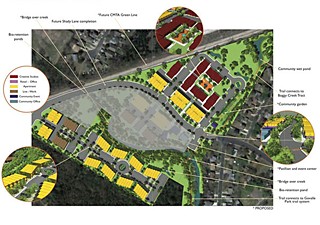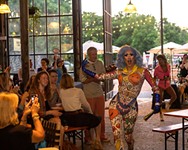All Over Creation: Site Specifics
Fusebox Festival helps the community envision a new kind of development with thinkEAST
By Robert Faires, Fri., Jan. 30, 2015
How often do you get to design the place where you live? Or where you work? Or where you live and work?
That's just one of the winning aspects of thinkEAST, a development project in East Austin that aims to create a mix of affordable housing, live/work spaces for artists, and studios while retaining the parklike properties of its 24-acre site. Rather than springing full-blown from the minds of the people who own the land and the planners they hire, this development is being crafted in large part by the community, through an 18-month process involving dialogue among stakeholders, meetings for public input, and, most uniquely, a pop-up prototype that will feature installations, workshops, classes, food events, and other programs on the site, as well as temporary structures for performances, to investigate and test some of the ideas proposed for thinkEAST before it's actually built.
Another winning aspect? This process is being coordinated by the good folks at Fusebox Festival. After Richard deVarga and Robert Summers purchased the notorious property – a onetime tank farm for jet fuel storage that took years of neighborhood activism to be shut down and cleaned up – with the idea of rehabilitating it (Winning Aspect No. 3), they approached Fusebox about helping them determine uses for the space. Since deVarga and Summers were especially interested in including artists and creative industries in any development (Winning Aspect No. 4), Fusebox applied for a grant from ArtPlace America – a consortium of 14 foundations, eight federal agencies, and six financial institutions that's all about creative placemaking – to support a planning process for thinkEAST. Its proposal was chosen for funding (to the tune of $400,000), and last summer the company and its partners – the owners/developers, the city's Cultural Arts Division, and entrepreneur Fred Schmidt – launched their "living charrette," which Fusebox Managing Director Brad Carlin calls a "radically inclusive, participatory way" of planning.
Fusebox Artistic Director Ron Berry says thinkEAST has two user groups: artists and neighborhood residents. But contrary to what you might think, those leading this process didn't start with the art. The Govalle and Johnston Terrace neighborhoods are the primary stakeholders in the minds of both the Fusebox team and the owners/developers, who have been coordinating their plans with the Govalle/Johnston Terrace Neighborhood Contact Team, the Guadalupe Neighborhood Development Corporation, and City Council. Writes Carra Martinez, an artist with the festival and its Scholar-in-Residence: "For Fusebox, thinkEAST involves not only activating the arts-based development of a charrette ... but also questioning and exploring how arts-based development engages with the history and cultures of East Austin."
That's why the first six months of the charrette was focused on the neighborhoods. Fusebox loaded its 30-member Stakeholder Advisory Group with area residents – those who had lived there a long time and newcomers both – and devoted its first two public meetings to learning the needs of people living there. What they learned, not surprisingly, is that affordability is the single biggest issue for the neighborhoods, with diversity and sustainability also emerging as major concerns.
Those three areas also came to the fore when Fusebox hosted its first stakeholder meeting for creatives on Jan. 18. Berry, Carlin, and Martinez faced questions about how the owners/developers define "affordable," how the dialogue about who this project serves isn't sanitized with regard to culture, and whether "cultural preservation" might be added to the project's vision and mission. The Fusebox leaders said they shared the concerns about cost and gentrification and reiterated their commitment to the neighborhoods. Berry offered some preliminary numbers regarding the housing – 300 units at 20% of market cost, with no apartment costing more than $1,000/month – though he added that these were goals and the real figures still had to be worked out. But he reeled off several "out-of-the-box financial strategies" being considered, including cooperatives, 30-year leases, shareholder arrangements, and community land trusts. The discussion also let Berry show that his team is seeking best-practice models for thinkEAST everywhere, from Project Row Houses in Houston to the Better Block Project that got its start in Dallas to Market Creek Plaza in San Diego to a network of centers in Brazil that offer arts, athletics, and dental care for working-class and lower-income families.
That's one indicator of why Fusebox's stewardship of this process is yet another Winning Aspect of thinkEAST. A decade of seeking out new forms of art – experimental forms, hybrid forms, forward-thinking forms, I-didn't-think-that-could-work-and-yet-it-does forms – has instilled in Berry and his team the conviction that new approaches to ingrained problems are out there and can be found and applied to our community. They're willing to explore all kinds of ideas for this project – the biggest, the boldest, the craziest – and use an arts festival to test them. If we, as a city, want to ensure that East Austin retains its history and culture in this era of rapid development, if we want to ensure that the artists who have helped shape Austin's character still have a place in it, then these are the kind of people who can help make thinkEAST a place where that happens.
But they need help – your help. As stated on the thinkEAST website, "This is the largest, most ambitious project Fusebox has taken on in its 11-year history. It's a process that will succeed based on the breadth and depth of engagement from local artists, residents, and community members." Look them up, get on board, and start designing the place where you live and work.












